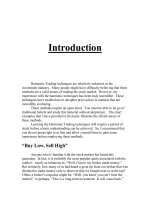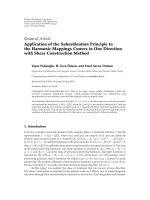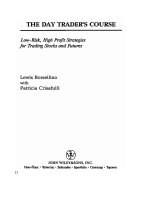the harmonic trader
Bạn đang xem bản rút gọn của tài liệu. Xem và tải ngay bản đầy đủ của tài liệu tại đây (23.36 MB, 305 trang )
Introduction
Harmonic Trading techniques are relatively unknown in the
investment industry. Many people might have difficulty believing that these
methods are a valid means of trading the stock market. However, my
experience with the harmonic techniques has been truly incredible. These
techniques have enabled me to decipher price action in markets that are
incredibly confusing.
These methods require an open mind. You must be able to let go of
traditional beliefs and study this material without skepticism. The chart
examples that I have provided will clearly illustrate the effectiveness of
these methods.
Learning the Harmonic Trading techniques will require a period of
study before a basic understanding can be achieved. So, I recommend that
you do not jump right in at first and allow yourself time to gain some
experience before employing these methods.
“Buy Low, Sell High”
Anyone who is familiar with the stock market has heard this
quotation. In fact, it is probably the most popular quote associated with the
market – nearly as infamous as: “Well, I know my broker made money.”
But seriously, how many of us had heard a great tip from our broker that was
destined to make money only to discover that we bought near or at the top?
Often, a broker’s response might be: “Well, you know you can’t time the
market;” or perhaps, “This is a long-term investment. It will come back.”
2
These justifications are worthless when your precious equity is declining
steadily, and your neighbor just made a double on the latest tech stock.
Buying low and selling high is possible but it requires many
ingredients to successfully invest in this manner. Successful investing
requires diligent work, patience, and specific rules to define opportunities.
Most people believe that you must sift through an overwhelming amount of
analysts' reports, news stories and financial statements to discover a
profitable investment opportunity. Unfortunately, the amount of information
available to consider is so vast that no one person could research all of the
pertinent material. Besides, which stories and financial data have the
greatest effect on moving a stock? Therefore, in order to discover
opportunities in the stock market, it is necessary to analyze the price action.
The Importance of Price Action
It is confounding that in an industry that focuses so much attention on
generating profits by rising market prices that the public is fed an amazing
gamut of financial statistics. Meanwhile, the price action of a particular
market is practically ignored. At this point you might seem skeptical,
asking: “What about earnings, industry reports, GNP, labor statistics?” I
don’t disagree that all of these sources have some degree of relevance to the
stock market. But, which ones effect which markets? Furthermore, if these
reports are disseminated to everyone, what edge do they possess for you?
Harmonic Trading provides the keys required to understand the nature
of price action. These techniques determine opportunities as defined by
historical patterns and price movements that have been continually repeated.
Based on such information, it is possible to identify highly probable
opportunities in the financial markets that currently possess the same
conditions. In essence, the Harmonic Trading approach provides a road map
of where prices have been and where they potentially can go. Unless we
understand this road map, we could very well be investing in the financial
markets at a point that is near the end of its trip.
Relying on Yourself
Investing can be a perilous endeavor, especially when you are relying
on someone else to produce profits. With these methods, you have the tools
to outperform the market averages on a consistent basis. Although it is
3
possible to achieve such returns, many people rely on mutual fund managers
or listen too closely to “market gurus” for their investing needs because they
claim that they don't have the time or the expertise to do the work.
Regardless of your investment experience, the fact remains that no one will
look after your money better than you! Thus, I must emphasize the
importance of accepting full
-responsibility for your investments and learning
as much as you can about handling your own money.
If you have the time and the desire to improve your results, you can
substantially out-perform the markets. If you take the time to study these
methods, to research trade set-ups, and to develop the patience to adhere to
these methodologies, you will be successful. The key to such success is to
understand prospective trading opportunities from an unbiased
perspective,
which is achieved through analyzing price action. If you can understand the
basics of price action, you will know when to buy and when to sell. The
ideal situation within the Harmonic Trading is to define high-probability
opportunities and to execute positions that are practically obvious, according
to specific rules of this methodology.
I have met many “long-term” investors who view the financial
markets as a passive savings account rather than active investment vehicle.
Their rationalization, as promoted by the industry, reasons that, if equity
capital is invested systematically over a long period of time, you should earn
a favorable return. Although this principle has been accurate in recent
history, especially in this latest bull-run that began in the early ‘80s, I
believe that such thinking lulls people into a false sense of security.
This long-term return philosophy has worked. However, the
philosophy has required that the investments be made in the largest
capitalized stocks or in the entire market as a whole via index funds. In fact,
historical returns have proven that the major market indices have
outperformed individual mutual funds. Moreover, individual funds have
been more volatile than the index vehicles. Despite these facts, many
individual investors, especially those whom contribute regularly to
Individual Retirement Accounts (I.R.A.), rely on this long-term philosophy
as a means of security. For many, this is sufficient but an active
management approach can provide greater returns.
Market Timing
This “buy-and-hold” strategy is advanced upon the notion that it is
extremely difficult, if not impossible, to accurately time the market. The
4
prevailing theme that many firms promote state that the individual investor
should invest consistently over a long-term time frame to be able to earn the
historical returns that such strategies yield. It is important to note that these
advisors are not
investing the money that they receive from these regular
contributors in the same manner. In fact, these advisors and mutual fund
managers are trying to time the market, by investing in potential investment
opportunities when they are identified. They typically do not arbitrarily
invest fixed sums of equity at regular time intervals. These money managers
are trying to buy low and sell high. So, in this sense, they are all
trying to
accurately time the market.
The interesting fact, especially throughout the past decade, is that the
market has provided opportunities to invest at significant discounts to their
yearly averages. Everyone knows that October historically has been a
troubling month for the major markets. But, these declines also have
provided substantial opportunities to buy investments for relatively cheap
prices. In recent history, after these declines occur, prices have rebounded
quite nicely. So, if you consider yourself an active trader or a passive
investor, timing the market can substantially improve your returns.
Another interesting point is that, regardless of when an individual
makes an investment, they are timing the market. Some, who buy near the
bottom, are timing their investments better than those who buy at the middle
or top. Therefore, it is important for all
market participants to consider
themselves as market timers.
It is a peculiar title to be a “market timer.” In my opinion, a market
timer is someone who patiently waits for investment opportunities. As I
stated before, the market periodically provides opportunities throughout the
year to buy stocks relatively cheap. Understanding this concept will prepare
you to wait for these opportunities. So, I urge you to give yourself more
credit and to understand that you do time the market, regardless of when
your money is invested.
Every Investor is a Trader
Another important concept to keep in mind is that all
investors are
traders. In general, a trader is often perceived as an individual who invests
on a short time frame only looking for a quick profit. Many mutual fund
managers and other “financial experts” warn that traders, especially
individual day traders, on the average fare worse than the returns that are
provided by long-term investing. Therefore, the general public should act as
5
investors, maintaining positions for long periods of time, and riding out the
ups and downs of the market.
Regardless of your time frame, it is imperative to assess each potential
market opportunity as a specific trade. If you are looking at an index fund, a
mutual fund or a stock, each potential investment is a trade. When you
commit money to these investments, you become a trader. Every time you
make an investment, you are developing market experience as a trader.
If you are a passive investor, I urge you to embrace these concepts of
market timing and trading. These concepts will require that you analyze
your investments, either I.R.A. contributions or actual trading transactions,
with more specific criteria before committing the equity capital. So, if you
have money in the market, remember that you are a trader.
The Nature of the Stock Market
The true nature of the stock market reflects nothing more than a finite
group of people, who are willing to buy and sell stocks based upon the
perception of an opportunity. For the buyer, he or she is willing to bid up
the price of a stock, believing that the stock will be worth more in the future.
Conversely, for the seller, he or she is willing to sell a stock believing that its
value will decline in the future. A stock will move up or rally if there are
more buyers than sellers, and move down if there are more sellers than
buyers. Although this is a simplified explanation of market dynamics, price
action behavior is encompassed within this definition. It is important to
understand these concepts, as the basic principles for trading the financial
markets. In essence, when this mass perception can be quantified or
"gauged," significant trade opportunities can be identified.
Harmonic Trading seeks to define the direction of mass perception by
quantifying the extent of buying or selling within specific time periods. The
harmonics of price action is determined through the recognition of specific
price structures and the exact alignment of Fibonacci numbers. Certain price
patterns help to identify the cyclical nature of a particular market's price
action. Also, it is important to understand that price action does move in
definite patterns that can be quantified by Fibonacci numbers. Once your
eyes are trained to perceive these set-ups, they will begin to jump out at you.
Identifying these patterns can be related to a heart specialist who reads
cardiograms. The doctor reads the output of the sound waves of the heart to
determine if it is operating in a healthy, rhythmic pattern. As the patient,
6
you might be seeing the results of your heart beating on the monitor. But,
unless you are trained to read the various blips, you will not be able to
completely understand the results.
In my opinion, these methods are the most effective means for
identifying trading opportunities in the financial markets. If you invest the
time and the effort to study this material, you can identify very profitable
opportunities. With this understanding, you will be able to read the "blips"
on a chart. Furthermore, you will be able to assess the true strength of a
stock accurately, to identify important reversal points and to know when to
execute trades.
I assure you, if you are reading this material now, you are on the edge
of a new beginning. These methods will offer a new way to view the market
from an unbiased perspective. In my opinion, the harmonic techniques are
the only
way to trade.
7
Part I
Harmonic Trading
8
9
1
Harmonic Trading
Harmonic Trading is a methodology that utilizes the recognition of
specific price patterns and Fibonacci ratios to determine highly probable
reversal points in stocks. This methodology assumes that trading patterns or
cycles, like many patterns and cycles in life, repeat themselves. The key is
to identify these patterns, and to enter or to exit a position based upon a high
degree of probability that the same historic price action will occur. Although
these patterns are not 100% accurate, these situations have been historically
proven. If these set-ups are identified correctly, you can discover significant
opportunities with a very limited risk.
One of the earliest references to Harmonic Trading can be found in
the work of J.M. Hurst. His Principle of Harmonicity states: “The periods
of neighboring waves in price action tend to be related by a small whole
number.” (Hurst, J.M.,
J.M. Hurst Cycles Course, Greenville, S.C.:
Trader’s Press, 1973.) The important concept to grasp is that price
waves or distinct price moves are related to each other. Furthermore,
Fibonacci ratios and price patterns manifest these relationships and
provide a means to determine where the turning points will occur.
When these turning points are identified correctly, trades are executed
at a price level where the cycle is potentially changing. Essentially,
this type of trading is respecting the natural ebb and flow of buying and
selling. In doing so, these trades are executed “in harmony” with the
10
market. For example, when a stock is bought at this turning point, the
majority of the selling that has persisted to drive the price down is very
close to ending. Quite often, the harmonic techniques identify trades at
or very close to the exact reversal point. When these trades yield valid
reversals, the true harmonic nature of price action becomes more
apparent.
Harmonic Trading techniques can be applied to any time frame -
hourly, daily, weekly or monthly stock charts. I believe the clearest trade
opportunities, or "set-ups," appear on daily charts. However, hourly charts
provide excellent set-ups for shorter-term or day trades. It is also amazing
that these methods work on longer-term charts, as well. Weekly or monthly
charts are excellent measures of historically critical areas for stocks. As you
will see, these methods will gauge price action effectively in any situation.
The most important principle inherent within the Harmonic Trading
approach is the ability to define various types of cyclical price action that
adheres to specific structural and ratio conditions. After gaining experience
with actual trades, the ability to decipher harmonic price action in the
markets will continue to improve. Price fluctuations represent cycles of
growth (rally) and decline (sell-off). Similar to many of life’s cyclical
growth processes, these movements can be measured by their relative
Fibonacci ratio relationships and analyzed to define unique technical
situations. In doing so, trades are executed at those areas where the natural
rhythm of the market is changing. Furthermore, these measurement
techniques will provide a great deal of technical information regarding the
potential direction of the future price action. This is particularly evident
when several harmonic calculations converge at a specific price area to
define critical support or resistance. This area is known as the Potential
Reversal Zone.
11
2
Potential Reversal Zone
An Area of Convergence
History has proven that a convergence of Fibonacci numbers and price
patterns provides a highly probable area for a reversal. When such a
congregation of numbers occurs, it is possible to assess an optimal point for
taking a trade, while defining a loss limit that it is very small relative to the
potential profit. This area of convergence is called the Potential Reversal
Zone.
The key to utilizing these harmonic measures when analyzing a price
chart is to determine the area where the greatest amount of calculated ratios
congregate. When three, four or even five numbers come together within a
specific area as defined by their respective structure, you must respect the
high probability for some type of reversal.
It is important to closely examine price action in the Potential
Reversal Zone. When a congregation of numbers occurs, the predominant
trend typically experiences some type of reaction that is different uniquely
from past price action. If a valid reversal does occur, often the price action
will typically bounce quickly from the area, holding in the reversal zone for
12
only a short period of time. However, if the reversal zone is invalid, the
price action usually will be extreme and will provide clear signals that this
trade opportunity is to be avoided.
The charts in this book illustrate how a convergence of harmonic
numbers has an unusual effect on price action. It is almost uncanny that the
markets act in such a manner. Although I will not engage in a discussion
that attempts to explain this phenomenon of price action, I know from
studying thousands of charts that a convergence of harmonic numbers has a
profound effect on the prevailing trend that must be considered.
"A Feel for the Numbers"
Once you learn these techniques, the Potential Reversal Zone can be
easily calculated. If you can add, subtract, multiply and divide, you can
determine the Potential Reversal Zone. However, determining which
number within the reversal zone is the best entry point for a trade can be a
tricky task. Developing “a feel for the numbers” within the harmonic area
takes practice and experience. But, there are general rules of thumb that will
help to optimize the execution within the Potential Reversal Zone.
Fibonacci numbers are very peculiar because in a reversal zone that
contains several harmonic calculations, it is difficult to know which point
will end the trend. Although these rules are generalizations, I believe that
there is a certain degree of weighting to the numbers.
In general, the bigger the number, the better. This means that the
Fibonacci number that is calculated from the largest price leg is usually the
most significant, as an entry point for a trade in a reversal zone. Another rule
of thumb is the bigger the pattern, the more significant the potential reversal.
For example, a pattern that develops on a weekly chart will be more
important than a set-up on a daily basis. Also, if there is a smaller pattern
within a larger pattern, the larger pattern usually will be more critical.
Another important consideration involves the harmonic numbers
within the Potential Reversal Zone. The amount of numbers that exist
within a specific area will frequently determine the importance of the
Potential Reversal Zone. This is an important consideration because a very
harmonic area will yield considerable technical information regarding the
prevailing trend's direction. For example, if a Potential Reversal Zone
contains four or five numbers, the area should be considered very harmonic.
If a price action reverses from this area, the Potential Reversal Zone could
13
be considered as an important turning point. But, if the price action does not
reverse, it would indicate that the predominant trend is quite strong.
The Potential Reversal Zone should be considered even more
harmonic, if the numbers are very close to each other. When a congregation
of harmonic numbers completes at nearly the same exact price level, the area
should be considered very significant. Also, when there is an area of three
or more numbers, it is important to examine where the closest convergence
of numbers occurs within that Potential Reversal Zone.
It is important to note that these methods are not an exact science - it's
more like an art. Although these methods do require precise calculations, a
“feel for the numbers” is essential to accurately gauge the price action, to
determine valid reversals and to optimize trade executions. These skills
require consistent dedication to research past harmonic examples and to
analyze current set-ups. The initial "training" period will be mentally
challenging. However, once you have gained experience with these
techniques, it will become much easier to identify harmonic opportunities
and to execute trades profitably.
I have a friend who recently earned his pilot’s license. Although he
was able to grab the controls and fly the plane on his first lesson (with the
instructor present), it took him almost a year of consistent flying before he
was able to really develop a feel for the airplane. On one flight, he allowed
me to take the controls. He instructed me to maintain the altimeter at a
specific level. I took command of the controls and started to fly the plane.
As I was flying the plane, I wanted to look out the cockpit and admire the
scenery around me. However, every time I looked out the window, the
plane’s altitude dropped. I would look back at the altimeter and ascend to
adjust our altitude back to the required height.
After flying the plane and maintaining the altitude by focusing directly on
the instrument gauges for a few minutes, my curiosity would get the better
of me. Sure enough, I would begin to sightsee. As soon as I did, the plane’s
altitude would drop. When my friend took over the controls after my
attempt to fly the plane, he was able to maintain the altitude precisely
without looking at the altimeter at all. He told me that it took him an initial
period of training before he was able to maintain the plane’s altitude without
looking at the altimeter. It required many hours of flying to develop his feel
for the plane.
In the same manner, these methods for identifying harmonic set-ups
require training and practical experience. Although you might be able to
calculate Fibonacci numbers and identify patterns that define potential
14
reversals, these methods require that special touch of intuition, earned
through dedicated and consistent work, before these techniques can truly be
mastered.
15
3
Gauging Price Action
Price Bars
Since a particular market's trading action is exhibited through
individual price bars, it is important to have a basic understanding of these
formations. There are four basic elements of a price bar: open, close, high,
and low. Although this may seem very simplistic, it is important to review
the nature of price bars because a stock's price action within the Potential
Reversal Zone will determine the validity of the harmonic set-up.
16
Bullish Price Bar
The open and the close define a bullish price bar. Simply, if the close
is above the open, the price bar is considered bullish. The degree of
bullishness can vary based upon the distance between the open and the close.
This simple illustration is very crucial because it defines the result of
trading within a specific time frame. Since a bullish price bar represents a
stock that closes above the open, it is possible to draw certain conclusions
regarding the price action. In essence, a bullish price bar manifests the result
of more buyers than sellers during that particular time period. When this
price bar appears in a bullish Potential Reversal Zone, it signifies that the
trend is potentially changing.
17
Bearish Price Bar
A bearish price bar is identified by the open and close, as well. In a
bearish price bar, the close is below the open.
Again, this is a very simple illustration. However, it is important to
understand this basic framework, to define price action. Similar to the
bullish price bar, the bearish price bar is the result of trading within a
specific period of time. However, the bearish price bar means that there are
more sellers than buyers. When this price bar forms in a bearish Potential
Reversal Zone, it can signal a reversal, as well.
18
Price Bars in the Potential Reversal Zone
As price action approaches a Potential Reversal Zone, it is important
to examine the nature of the price bars. This will help determine the validity
of a potential reversal within the harmonic area. The nature of the price bars
also will indicate the strength or weakness of the price action.
In a Potential Reversal Zone, there is a specific price range, where the
price action "should" turn around. I say "should" because the Potential
Reversal Zone is an area that is highly probable for a turn around. It is not
100% guaranteed. However, as you will see, the harmonic zones do identify
excellent areas for potential reversals. Therefore, the individual price bars
within this harmonic area will determine the validity of that potential
reversal.
Ideal Reversals
Ideal reversals frequently occur in Potential Reversal Zones.
Sometimes, price action will reverse exactly off an important calculated
harmonic support or resistance area. These instances are easy to decipher.
However, the ideal reversal does not always occur in a Potential Reversal
Zone. If you understand how a reversal "should" occur, you will be able to
decipher valid reversals within a harmonic area.
There are two important aspects of a reversal to observe within this
harmonic area. The most important characteristic of the price action in the
Potential Reversal Zone is some type of turn around or change in the
previous trend. This would be evidenced by price action that exhibits a price
bar that is opposite to the predominant trend. For example, if you were
looking to buy a stock that was forming a bullish pattern, you would want to
see a bullish price bar in the Potential Reversal Zone. As the price action is
declining, it most likely would form bearish price bars. However, if the
trend started to reverse, as evidenced by bullish price bars in the harmonic
area, a potential reversal could be developing. Reversals in an area with
several harmonic numbers often form in this fashion. But, one price bar that
is opposite to the current trend does not entirely signify a valid reversal.
19
Reversal Continuation
The other element of a valid reversal is some type of continuation of
that change in trend. Using the bullish example again, if price action started
to rally after hitting the Potential Reversal Zone, it should be followed by
another bullish price bar. In this example, it would be ideal if the price bar
rallied and closed above the previous high, while maintaining a higher low.
The concept of a continuation is essential in providing evidence of a valid
reversal. Although the following illustrations are very simplistic, it is
important to have an understanding of standard reversal action.
Ideal Bullish Reversal
In an ideal bullish reversal, it is important to see a bullish price bar in
the Potential Reversal Zone. Ideally, a bullish continuation will validate the
reversal.
Obviously, this is an ideal situation. But, price action that reverses in
such a manner after hitting a harmonic area represents an ideal situation.
The important concept is to witness some type of turn around, followed by
20
price action that has higher highs and higher lows. In addition, the price
action should continue to form bullish closes - that is, higher than the open.
Ideal Bearish Reversal
In an ideal bearish reversal, it is also important to observe price action
in the Potential Reversal Zone. When the price action hits the harmonic
area, it is important to see a bearish price bar, followed by a continuation of
that new downtrend.
The primary signs of the bearish continuation will be price action that
makes lower highs and lower lows, after the reversal is complete. Also, the
individual price bars should continue to close below the open. These are the
primary signs that will validate a bearish reversal.
Although these concepts may seem over-simplified, they serve as
standards by which valid reversals can be determined. Establishing some
type of standards of price action will create a better understanding of a valid
reversal. This understanding will help you develop a "feel" for how a price
action "should" act in the Potential Reversal Zone. Although certain
markets do reverse in harmonic areas that vary from the ideal illustrations,
21
these basic concepts will help identify valid reversals that can yield
substantial moves.
Japanese Candlesticks
Another method to exhibit a price bar is a Japanese Candlestick.
These formations illustrate the nature of a price bar in a very clear manner. I
utilize Candlestick charts extensively in my trading. Also, I present all of
the examples of harmonic patterns throughout this book using Japanese
Candlesticks.
Charting markets with this type of a price bar has been around for
centuries. Originally, Japanese Candlesticks were developed to chart the
price of rice markets. There are several excellent books on candlesticks that
I recommend you read. One of the most comprehensive books that I have
ever read on Japanese Candlesticks is Japanese Candlestick Charting
Techniques, by Steve Nison. (New York: New York Institute of Finance,
1991.) It is a fascinating area of Technical Analysis. However, for these
purposes, I will illustrate only the most basic of candlestick price bars.
Bullish Candlestick
22
A price bar that has an area that is clear or white represents a bullish
Candlestick. As you can see, the enlarged area shows the difference
between the open and the close.
The Candlestick illustrates the price action more clearly than a single,
line price bar. Also, in combination with a harmonic set-up, the Candlestick
can provide greater indication of a potential reversal.
Bearish Candlestick
A filled or black bar depicts the bearish Candlestick. This price bar
also shows the range between the open and close more clearly than a single,
line price bar.
Candlesticks are excellent measures of price action because they
clearly illustrate the range between the open and close. Although the total
range of the price bar is important, the difference between the open and the
close can provide even greater indication of future direction.
23
Other Significant Japanese Candlesticks
Other candlestick formations are very significant when they
materialize in a Potential Reversal Zone. These candlesticks provide an
even stronger indication of a potential reversal when they form in a
harmonic area.
Doji
The Doji is an excellent potential reversal signal. It occurs when the
open and the close are the same. Usually, the open and the close are found
in the middle of the price range.
This price bar indicates a market that is uncertain of its future action.
It is important to closely watch the price action following the formation of
this price bar, as this will often provide clear signals regarding the future
trend of a stock.
24
Hammer
The hammer is a price bar that has a large total range with a small
difference between the high and the low. This difference should be
approximately 1/3 the total range for a valid hammer. Depending on where
it develops on the chart, there are other terms for this price bar, such as a
Hangman or Shooting Star. However, for these purposes, it is important just
to recognize this as a reversal signal, especially when it forms in a Potential
Reversal Zone.
The next illustration shows a hammer that is inverted. Again, it is
important to recognize this sign as an indication of a potential reversal when
it develops in a harmonic area.
25
Japanese Candlesticks clearly illustrate each bar of price action. I
believe that Candlesticks can indicate a great deal more about a future price
action than a single, line price bar. Also, there are several combinations of
candlesticks that identify critical turning points in stock. I strongly
encourage you to study this area of Technical Analysis. Although these are
very basic illustrations and explanations of candlesticks, it is important to
recognize these price bars as reversal formations in a Potential Reversal
Zone.

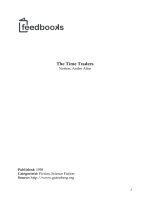
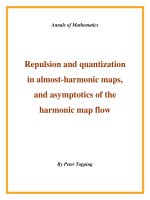
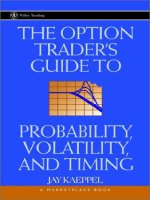
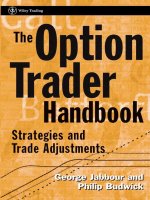

 pdf](https://media.store123doc.com/images/document/14/ri/ma/medium_ULM1gCf9v4.jpg)
